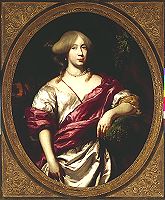 click to enlarge |
PORTRAIT OF ENGELBERTA VAN BRIENENNicholaes Maes SN 266, oil on canvas, mid-1670s Go also to engelberta.com
|
ARTIST:
Nicholaes Maes was born in Dordrecht in 1634, the son of a prosperous merchant. He learned to draw from a mediocre master in his native town, but at the age of 12 left to study with Rembrandt in Amsterdam. By 1653 he was back in Dordrecht painting portraits and genre. For a brief period in the mid 1650’s, Maes was ranked among the most innovative genre painters, adapting Rembrandt’s brushstrokes and chiaroscuro to his scenes of domestic life.
But he had a real talent for portraiture – which paid better. His use of bright colors and emphasis on elegant clothing guaranteed him a rush of patrons. From 1660 until the end of his career he worked exclusively as a portraitist. In 1673 he settled in Amsterdam where he enjoyed a most lucrative career. His portraiture was international in feeling, and he was equal to his colleagues in Europe at the end of the 17th c. He died in Amsterdam.
SUBJECT:
Engelberta van Brienen is about 20 in this painting; she was born in 1653 and died at 63, in 1716. She was married to Paulus Voet van Winssen (1651-1720), burgomaster of Utrecht and holder of many other official positions. (Maes painted a portrait of him as well, in 1675.)
This is the second example in the Ringling Museum of Maes’ elegant portrait style. He was prolific in painting the Dutch regent class in a format practiced by many artists in Amsterdam and The Hague, based on Flemish prototypes. Maes didn’t bother to flatter his sitters as so many of his contemporaries did, so we’re safe to assume that we could have recognized the sitter from this picture.
PAINTING:
Maes has given us another ¾-length portrait of a wealthy society woman. She is wearing satin with just the slightest hint of décolletage, and has her hair coifed in the latest style. Her pearl earrings and necklace are repeated in the pearls of her sleeve decoration. A jeweled strap supports her stole. In other words, she has been peeking at the French fashion catalogs.
Before 1660 Maes had done about 100 genre subjects, of which virtually none have survived. But from that point on about 400 portraits are known…and well over half are women. There were many burger families who wished to forget the commercial origins of their fortunes by having their wives and children painted as ladies and gentlemen of leisure, posed in rich interiors or impressive landscaped gardens. Here, Engelberta leans against a mossy garden statue, suggesting that such accessories are routine in her life.
HISTORIC CONTEXT:
We like to say that the art of any period reflects the conditions of its time - and nowhere is this so true as in Dutch Baroque art. 17th c. Dutch art is unique, and the reasons are political, religious, and economic.
Charles V’s son, Philip, succeeded him on the Spanish throne - and he couldn’t have cared less about the Netherlands except as a tax base. In due course (1570), the Netherlanders revolted. The outcome was independence and Protestantism for the 17 northern provinces. (The 10 southern ones, now Belgium, remained Spanish Catholics.) This had a resounding effect on Dutch art.
Now, instead of painting to decorate Catholic churches, Dutch artists portrayed the world around them. As a result we know what the 17th c. Dutch wore, ate, how they set their tables, how they worked, and how their kids played.
As for portraiture, it bloomed! With no cameras, portraits offered a visual family record. Commissioned to celebrate engagements and weddings, they were usually pendants (facing pairs). Civic groups would have group portraits painted. All this reflected the wealthy burgers’ pride in themselves, their families, their social position. Older generations show dark dress, white collars, millstone ruffs…a no nonsense attitude, partly held over from Spanish somberness. But later on, French fashion sneaked in; disguised as Venus, one could wear a fancy coiffure and show a little décolletage.
The more attention to detail, the higher quality the portrait - and indication of the artist’s skill. Artists were fascinated with technical virtuosity, and they celebrated the new wealth which allowed purchase of costly, exotic objects to be included in the painting. Frames, however, were simpler, generally black or tortoise shell.
FRANCO-DUTCH WAR (1672-1678)
However, France's attack of The United Provinces (Holland) in 1672, marked the beginning of a rivalry between two powerful men in Europe: William III (who would later invade England in support of the claim of his wife, Queen Mary II, to the English throne as part of the "Glorious Revolution") and Louis XIV. They, along with their respective allies, would be pitted against each other in a series of wars in the years that followed.
This marked the end of the "Golden Age" for Holland.
Engelberta has her own website. Go here and read about her family her descendants and her mansions.